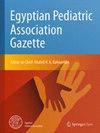Pediatric demographic association with hospital mortality in platelets- and plasma-transfused young pediatric patients — a mixed cohort study
IF 0.5
Q4 PEDIATRICS
引用次数: 0
Abstract
Demographic and biochemical variations in newborn children as compared to adults are attributable to variable prognosis to blood transfusions. Aims of this mixed cohort study of Platelets with/without Plasma (PLT/PZ); only Plasma (PZ) transfusions in ≤ 24 months children is as follows: An Association of demography towards hospital mortality, and an association of laboratory investigations (LI) with hospital mortality. PLT/PZ (n = 72) and PZ (n = 79) children ≤ 24 months were followed up for a total length of hospital stay (LOS(D)). We calculated the Odds Ratio (OR) of demographic, and laboratory parameters for mortality, survival studies of demographic, laboratory parameters , Kaplan Meier Survival curve, Log-Rank significance (KMLR) and Multivariable regression (r2) with outcome as death. The present study is in 2019–2022. Higher OR for hospital-based mortality for PLT/PZ and PZ cohort were age ≤ 1 m, weight ≤ 1500 g, preterm, gestational age ≤ 34 weeks, hospital length of stay {LOS(D)} 0–7 days, APGAR score ≤ 5, and Hb ≤ 7 g/dl. High OR, mortality was observed with Female gender, Length of stay before first transfusion {LOS(F)}, 0-7d, WHO Grade of bleeding (GOB) 4, PT>50 sec, INR>1·7, aPTT >75sec, PLT counts (μl) ≤25000/μl (PLT/PZ) and GOB 3, 4 (PZ). Higher OR for mortality was also observed with a lower derangement of coagulative parameters PT≤50s, INR ≤1·7, aPTT ≤75s (PZ). Higher survival was observed for (PLT/PZ) LOS(F) 0–7 days across age (m), weight (g) (P = 0·002; < 0·01), and INR ≤ 1·7; aPTT ≤ 75 s across LOS(D) (P < 0·01,0·018); (PZ) LOS(D) ≤ 7 days across age (m) and weight (g) (P = 0·036, 0·001); and GOB across LOS(D) (PLT/PZ; PZ) (P = 0·052, 0·005). Demography (PLT/PZ) r2 = 50·36% (P = 0·021), laboratory investigations r2 = 10·44% (P = 0·47), LOS(F) (P = 0·010), LOS(D) (P = 0·003), and GOB (P = 0·03) were the predictors. Demography (PZ) r2 (P = 0·095), investigations r2 = 8·79% (P = 0·254), LOS(D) (P = 0·026), and GOB (P = 0·012) were the predictors. PLT/PZ, demographic parameters, were significant cause of mortality with LOS(F), LOS(D), and GOB as predictors. PZ, demography attributed to mortality with LOS(D), and GOB as predictors. A higher OR of morality with lower derangement of laboratory profile is indicative of unnecessary transfusions in the age group. Laboratory investigations by themselves are not significant predictors of mortality.血小板和血浆输注的年轻儿科患者住院死亡率与儿科人口统计学的关系--一项混合队列研究
与成人相比,新生儿在人口统计学和生化方面的差异可导致输血预后的不同。这项针对 24 个月以下儿童输注血小板(PLT/PZ)和血浆(PZ)的混合队列研究的目的如下:人口统计学与住院死亡率的关系,以及实验室检查(LI)与住院死亡率的关系。对≤24个月的PLT/PZ(n = 72)和PZ(n = 79)儿童的住院总时间(LOS(D))进行了随访。我们计算了人口统计学和实验室参数与死亡率的比值比(OR)、人口统计学和实验室参数的生存研究、卡普兰-梅耶生存曲线、对数方差显著性(KMLR)和以死亡为结果的多变量回归(r2)。本研究的时间为 2019-2022 年。年龄≤1米、体重≤1500克、早产、胎龄≤34周、住院时间{LOS(D)}0-7天、APGAR评分≤5分、血红蛋白≤7克/分升是PLT/PZ和PZ队列的较高住院死亡率OR。女性、首次输血前住院时间{LOS(F)}为0-7天、WHO出血等级(GOB)为4、PT>50秒、INR>1-7、aPTT>75秒、PLT计数(μl)≤25000/μl(PLT/PZ)和GOB为3、4(PZ)的患者死亡率较高。凝血参数 PT≤50s, INR≤1-7, aPTT≤75s (PZ) 较低时,死亡率也较高。在不同年龄(米)、体重(克)(P = 0-002;< 0-01)和 INR ≤ 1-7 的情况下,(PLT/PZ)LOS(F) 0-7 天的存活率较高;在不同 LOS(D) 的情况下,aPTT ≤ 75 秒的存活率较高(P < 0-01,0-018);(PZ) LOS(D) ≤ 7 天,跨年龄(米)和体重(克)(P = 0-036,0-001);GOB 跨 LOS(D) (PLT/PZ;PZ)(P = 0-052,0-005)。人口统计学(PLT/PZ)r2 = 50-36% (P = 0-021)、实验室检查 r2 = 10-44% (P = 0-47)、LOS(F) (P = 0-010)、LOS(D) (P = 0-003) 和 GOB (P = 0-03) 是预测因素。人口统计学(PZ)r2(P = 0-095)、调查 r2 = 8-79% (P = 0-254)、LOS(D) (P = 0-026) 和 GOB (P = 0-012) 是预测因子。PLT/PZ、人口统计学参数是导致死亡的重要原因,LOS(F)、LOS(D)和GOB是预测因素。PZ、人口统计学参数是死亡率的重要原因,LOS(D)和GOB是预测因素。实验室检查结果失常程度越低,死亡率越高,这表明该年龄组存在不必要的输血。实验室检查本身并不能显著预测死亡率。
本文章由计算机程序翻译,如有差异,请以英文原文为准。
求助全文
约1分钟内获得全文
求助全文
来源期刊

Egyptian Pediatric Association Gazette
PEDIATRICS-
自引率
0.00%
发文量
32
审稿时长
9 weeks
期刊介绍:
The Gazette is the official journal of the Egyptian Pediatric Association. The main purpose of the Gazette is to provide a place for the publication of high-quality papers documenting recent advances and new developments in both pediatrics and pediatric surgery in clinical and experimental settings. An equally important purpose of the Gazette is to publish local and regional issues related to children and child care. The Gazette welcomes original papers, review articles, case reports and short communications as well as short technical reports. Papers submitted to the Gazette are peer-reviewed by a large review board. The Gazette also offers CME quizzes, credits for which can be claimed from either the EPA website or the EPA headquarters. Fields of interest: all aspects of pediatrics, pediatric surgery, child health and child care. The Gazette complies with the Uniform Requirements for Manuscripts submitted to biomedical journals as recommended by the International Committee of Medical Journal Editors (ICMJE).
 求助内容:
求助内容: 应助结果提醒方式:
应助结果提醒方式:


